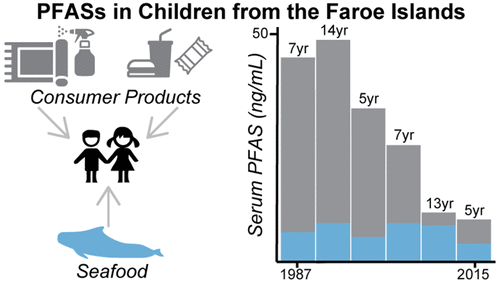当前位置:
X-MOL 学术
›
Environ. Sci. Technol.
›
论文详情
Our official English website, www.x-mol.net, welcomes your feedback! (Note: you will need to create a separate account there.)
Shifting Global Exposures to Poly- and Perfluoroalkyl Substances (PFASs) Evident in Longitudinal Birth Cohorts from a Seafood-Consuming Population
Environmental Science & Technology ( IF 11.4 ) Pub Date : 2018-03-12 00:00:00 , DOI: 10.1021/acs.est.7b06044 Clifton Dassuncao 1, 2 , Xindi C. Hu 1, 2 , Flemming Nielsen 3 , Pál Weihe 4 , Philippe Grandjean 1, 3 , Elsie M. Sunderland 1, 2
Environmental Science & Technology ( IF 11.4 ) Pub Date : 2018-03-12 00:00:00 , DOI: 10.1021/acs.est.7b06044 Clifton Dassuncao 1, 2 , Xindi C. Hu 1, 2 , Flemming Nielsen 3 , Pál Weihe 4 , Philippe Grandjean 1, 3 , Elsie M. Sunderland 1, 2
Affiliation

|
Rapid declines in legacy poly- and perfluoroalkyl substances (PFASs) have been reported in human populations globally following changes in production since 2000. However, changes in exposure sources are not well understood. Here, we report serum concentrations of 19 PFASs (∑19PFAS) measured in children between 1993 and 2012 from a North Atlantic fishing community (Faroe Islands). Median ∑19PFAS concentrations in children (ages 5–13 years) peaked in 2000 (47.7 ng mL–1) and declined significantly by 14.4% year–1 until 2012. Principal component analysis (PCA) identified two groups of PFASs that likely reflect exposures from diverse consumer products and a third group that consisted of perfluorocarboxylic acids (PFCAs) with nine or more carbons (C ≥ 9). These C ≥ 9 PFASs are strongly associated with mercury in children’s hair, a well-established proxy for seafood consumption, especially perfluoroundecanoic acid (PFUnDA, r = 0.72). Toxicokinetic modeling shows PFAS exposures from seafood have become increasingly important (53% of perfluorooctanesulfonate, PFOS, in 2012), despite a decline in whale consumption in recent years. We infer that even in a major seafood-consuming population, declines in legacy PFAS exposure after 2000 were achieved by the rapid phase out of PFOS and its precursors in consumer products. These results emphasize the importance of better understanding exposures to replacement PFASs in these sources.
中文翻译:

从全球海产品消费人群的纵向出生队列来看,全球暴露于聚和全氟烷基物质(PFASs)的转移
据报道,自2000年以来生产发生变化,全球范围内的人类中传统的多氟烷基和全氟烷基物质(PFAS)迅速减少。但是,人们对暴露源的变化知之甚少。在此,我们报告了1993年至2012年之间从北大西洋渔民社区(法鲁群岛)在儿童中测得的19种PFAS的血清浓度(∑ 19 PFAS)。中位Σ 19种PFAS浓度的儿童(年龄5-13岁)达到高峰,2000(47.7纳克毫升-1),并通过增长14.4%显著下跌-1直到2012年。主成分分析(PCA)确定了两组PFAS,它们很可能反映了来自不同消费产品的暴露,第三组包括具有九个或更多碳(C≥9)的全氟羧酸(PFCA)。这些C≥9 PFAS与儿童头发中的汞密切相关,这是海鲜消费的公认替代品,尤其是全氟十一烷酸(PFUnDA,r= 0.72)。毒代动力学模型显示,尽管近年来鲸鱼的消费有所减少,但海鲜中PFAS的暴露已变得越来越重要(2012年全氟辛烷磺酸为PFOS的53%)。我们推断,即使在一个主要的海产品消费人群中,由于迅速淘汰了全氟辛烷磺酸及其消费品中的前体,在2000年以后,传统的全氟辛烷磺酸暴露量也有所下降。这些结果强调了更好地了解这些来源中替代PFAS暴露的重要性。
更新日期:2018-03-12
中文翻译:

从全球海产品消费人群的纵向出生队列来看,全球暴露于聚和全氟烷基物质(PFASs)的转移
据报道,自2000年以来生产发生变化,全球范围内的人类中传统的多氟烷基和全氟烷基物质(PFAS)迅速减少。但是,人们对暴露源的变化知之甚少。在此,我们报告了1993年至2012年之间从北大西洋渔民社区(法鲁群岛)在儿童中测得的19种PFAS的血清浓度(∑ 19 PFAS)。中位Σ 19种PFAS浓度的儿童(年龄5-13岁)达到高峰,2000(47.7纳克毫升-1),并通过增长14.4%显著下跌-1直到2012年。主成分分析(PCA)确定了两组PFAS,它们很可能反映了来自不同消费产品的暴露,第三组包括具有九个或更多碳(C≥9)的全氟羧酸(PFCA)。这些C≥9 PFAS与儿童头发中的汞密切相关,这是海鲜消费的公认替代品,尤其是全氟十一烷酸(PFUnDA,r= 0.72)。毒代动力学模型显示,尽管近年来鲸鱼的消费有所减少,但海鲜中PFAS的暴露已变得越来越重要(2012年全氟辛烷磺酸为PFOS的53%)。我们推断,即使在一个主要的海产品消费人群中,由于迅速淘汰了全氟辛烷磺酸及其消费品中的前体,在2000年以后,传统的全氟辛烷磺酸暴露量也有所下降。这些结果强调了更好地了解这些来源中替代PFAS暴露的重要性。


























 京公网安备 11010802027423号
京公网安备 11010802027423号